The Southern Cross is an asterism formed by the brightest stars in the constellation Crux. Largely unknown to observers in the northern hemisphere, it is the most familiar star pattern in the far southern night sky. The asterism carries cultural meaning and significance in many countries in the southern hemisphere.
Composed of four (or five) stars that form the pattern of a diamond, the Southern Cross is the most distinctive feature of the constellation Crux, the smallest constellation in the sky. It gives the constellation its English name, the Southern Cross.
The stars that form the Southern Cross are Acrux (Alpha Crucis), Mimosa (Beta Crucis), Gacrux (Gamma Crucis), Imai (Delta Crucis), and Ginan (Epsilon Crucis). Three of these stars – Acrux, Mimosa and Imai – are hot, massive B-type stars that likely share a common origin. They are less than 20 million years old. Gacrux and Ginan are red giants (class M and class K). They are much older stars and do not belong to the same family.
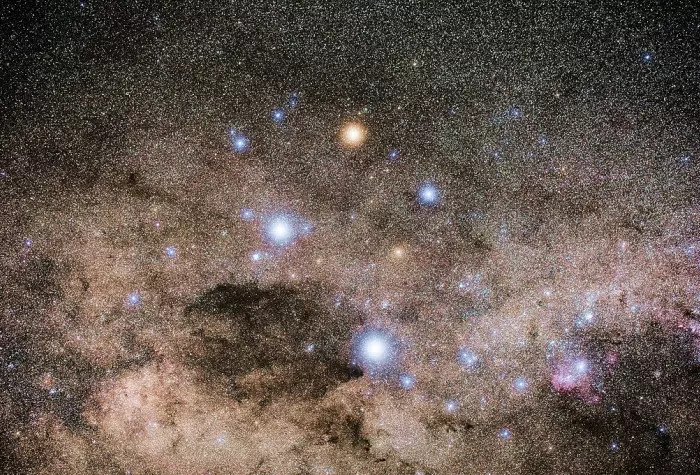
Wide field image of the Southern Cross, credit: Wikimedia Commons/Naskies (CC BY-SA 3.0)
Unlike constellations, asterisms are not strictly defined and do not have formal boundaries. Two or more versions of a single asterism may exist. The Southern Cross is probably the most famous example. Some observers include Ginan (Epsilon Crucis), while others do not. The faintest of the five stars is not part of the cross or diamond pattern, but it makes the asterism distinctive and easy to recognize.
The Southern Cross has historically played a key role in navigation because its two bright stars, Acrux and Gacrux, point in the direction of the southern celestial pole. In the southern hemisphere, the asterism has great cultural significance and is featured on several national flags, including those of Australia and New Zealand. The flag of Australia features five stars, while that of New Zealand includes only the main four.
Constellation
The Southern Cross is the most visible part of the constellation Crux. It is also the constellation’s English name. The Latin word crux means “cross.”
Crux is the smallest constellation in the sky, covering an area of only 68 square degrees. It appears on the southern end of the Milky Way’s visible band. Even though it is small, Crux is easily recognizable because it contains two first-magnitude stars – Acrux and Mimosa – and a total of five stars brighter than magnitude 3.00. These are the stars that form the Southern Cross.
In Ptolemy’s time, Crux was part of the constellation Centaurus. It was visible to the Ancient Greeks, but the Earth’s axial precession gradually took the stars of Crux to the far southern sky, making them invisible from most locations in the northern hemisphere. By the year 400 CE, the Southern Cross had fallen below the horizon for most of Europe. It was rediscovered by European explorers in the 15th and 16th centuries.
Southern Cross stars
The five stars that form the Southern Cross are: Acrux (Alpha Crucis), Mimosa (Beta Crucis), Gacrux (Gamma Crucis), Imai (Delta Crucis), and Ginan (Epsilon Crucis). Alternatively, the asterism is formed only by the four brighter stars, and Ginan is omitted.
Gacrux sits at the top of the Cross, Acrux is at the base, and Gacrux and Imai form the crossbeam. Ginan appears within the cross pattern, between Imai and Acrux.
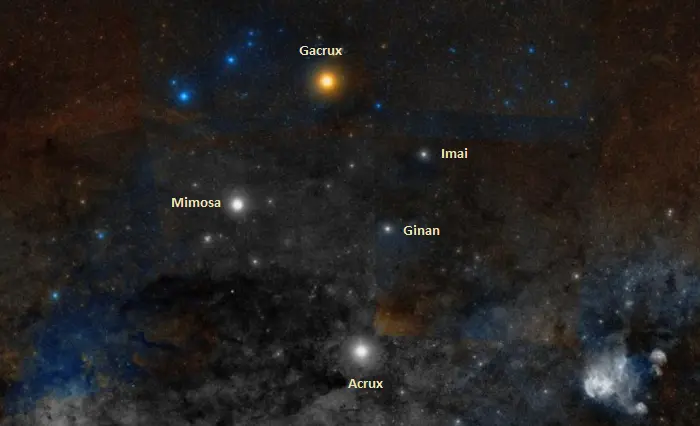
The Southern Cross stars, image: Wikisky
The stars of the Southern Cross are some of the brightest stars in the sky. The constellation’s luminary, Acrux, is the 13th brightest star in the sky. With an apparent magnitude of 0.76, it is imperceptibly fainter than Altair in the constellation Aquila and narrowly outshines Aldebaran in Taurus and Antares in Scorpius. Acrux is the southernmost of the 21 first-magnitude stars.
Mimosa shines at magnitude 1.25 and is the 20th brightest star in the sky. It is only very slightly fainter than the supergiant Deneb in Cygnus and it outshines Regulus in Leo, Adhara in Canis Major, and Castor in Gemini. The star is also known as Becrux, but its formal name (approved by the International Astronomical Union) is Mimosa.
Gacrux is the 25th brightest star in the sky, shining at magnitude 1.64. It is brighter than Bellatrix and the stars of Orion’s Belt, and almost as bright as Castor in Gemini and Shaula in Scorpius.
The names of the three brighter stars – Acrux, Becrux and Gacrux – are contractions of the stars’ Bayer designations, Alpha, Beta and Gamma Crucis, and the name of the constellation, Crux. They may have been coined by the 19th century American cartographer and astronomy writer Elijah Hinsdale Burritt, who published several editions of Atlas of the Heavens between 1833 and 1856. The names Acrux and Gacrux were formally approved for Alpha and Gamma Crucis by the International Astronomical Union (IAU) in 2016, and Becrux has the official name Mimosa.
| Star | Acrux | Mimosa | Gacrux | Imai | Ginan |
| Bayer designation | Alpha Crucis (α Cru) | Beta Crucis (β Cru) | Gamma Crucis (γ Cru) | Delta Crucis (δ Cru) | Epsilon Crucis (ε Cru) |
| Spectral type | B0.5IV + B1V | B0.5 III/B2V | M3.5 III | B2 IV | K3 III |
| Apparent magnitude | 0.76 (1.33 + 1.75) | 1.25 (1.23 – 1.31) | 1.64 | 2.79 | 3.58 |
| Distance | 320 ly | 280 ly | 88.6 ly | 345 ly | 230 ly |
| Mass | 17.80 M☉ | 16 M☉ | 1.5 M☉ | 8.9 M☉ | 1.52 M☉ |
| Radius | 7.8 R☉ | 8.4 R☉ | 120 R☉ | 8 R☉ | 28.41 R☉ |
| Luminosity | 25,000 L☉ | 34,000 L☉ | 758 L☉ | 10,000 L☉ | 302 L☉ |
| Temperature | 24,000 K | 27,000 K | 3,689 K | 22,570 K | 4,294 K |
Acrux (Alpha Crucis)
Acrux (Alpha Crucis) is the brightest star in the Southern Cross and in the constellation Crux. It shines at magnitude 0.76 from a distance of 320 light-years. It is the most massive of the five stars that form the asterism.
Acrux appears as a single star to the unaided eye but is in fact the primary component in a six-star system. Optical telescopes will reveal a triple star: the brighter components Acrux A (Alpha1 Crucis) and Acrux B (Alpha2 Crucis) and a fainter, more distant Acrux C (HR 4729). Acrux A shines at magnitude 1.40, Acrux B at 2.09, and Acrux C at 4.79.
Acrux A and Acrux B orbit each other at a minimum separation of 430 astronomical units with a period of about 1,500 years.
Acrux A is itself a spectroscopic binary system composed of two stars that orbit each other with a period of 76 days at a distance of about 1 astronomical unit (Earth – Sun distance).
The primary component, Alpha Crucis Aa, is a hot blue subgiant of the spectral type B0.5 IV. With a mass 17.80 times that of the Sun, the star is a supernova candidate. It has a radius 7.8 times solar and is 25,000 times more luminous than the Sun, with an effective temperature of 24,000 K. Acrux is a fast rotator, spinning at 120 km/s.
The brighter companion (Acrux B) has the stellar classification B1V, indicating a hot, blue main sequence star. It is separated by 4 arcseconds from Acrux A. It has an apparent magnitude of 2.09.
Acrux C (HR 4729) is another spectroscopic binary. It shines at magnitude 4.79 and has the spectrum of a blue main sequence star of the spectral type B5 V. It was discovered as a companion to Acrux in 1829. The orbital elements were calculated in 1979. Acrux C appears 90 arcseconds away from the brighter triple star and has a similar proper motion. This indicates that it shares the same origin and may be gravitationally bound to Acrux A and B.
Acrux C has a close companion, designated Alpha Crucis D, P or CP, which appears only 2 arcseconds away. The component D is a 15th magnitude star. Its faintness indicates that it may be a red dwarf.
In Portuguese, Acrux is known as Estrela de Magalhães (Star of Magellan).
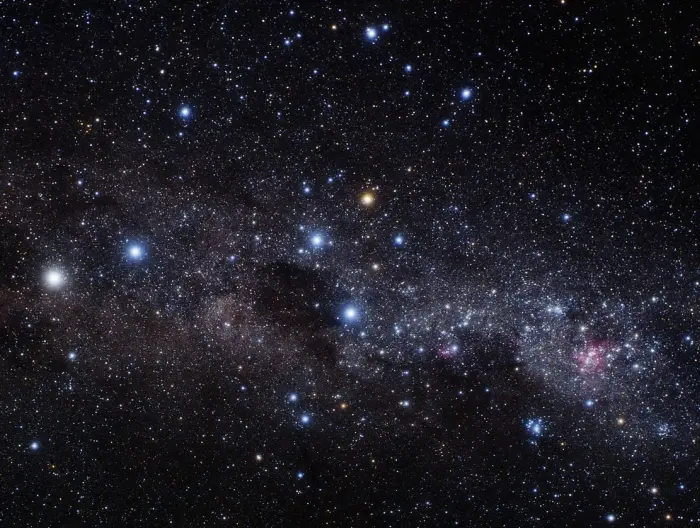
The Southern Pointers (Alpha and Beta Centauri) and the Southern Cross, image credit: A. Fujii (CC BY 4.0)
Mimosa (Beta Crucis)
Mimosa (Beta Crucis) is a blue giant star of the spectral type B0.5 III. It is part of a binary and possibly a triple star system. It is the hottest and most luminous of the Southern Cross stars.
Beta Crucis is a spectroscopic binary star. The two components are too close together to resolve even in the largest of telescopes. They orbit each other every 5 years at a distance that varies from 5.4 to 12 astronomical units. The estimated age of the system is between 8 and 11 million years.
The primary component, formally known as Mimosa, has a mass 16 times that of the Sun and a radius about 8.4 times solar. It shines with 34,000 solar luminosities with a surface temperature of about 27,000 K. The companion is also massive enough to be a supernova candidate. It has a mass 10 times that of the Sun and may be a main sequence star of the spectral type B2 V.
Mimosa is classified as a Beta Cephei variable. Its brightness varies from magnitude 1.23 to 1.31 due to pulsations of its surface. The star is losing mass – about 10−8 M☉ or 1 solar mass every 100 years – through a powerful stellar wind with a velocity of 2,000 km s-1 or more.
A third component was announced in 2007. It may be a low-mass pre-main-sequence star. It was discovered using the Chandra X-ray Observatory.
The name Mimosa comes from the Latin word for “actor.” It may also come from the flower mimosa.
Gacrux (Gamma Crucis)
Gacrux (Gamma Crucis) is a red giant of the spectral type M3.5 III. Located at a distance of 88.6 light years, it is the nearest red giant to the Sun. It is the nearest, coolest and by far the largest of the five stars of the Southern Cross.
The star has a mass of 1.5 solar masses. As it evolved away from the main sequence, it has expanded to a size of 120 solar radii. It is 758 times more luminous than the Sun with a surface temperature of 3,689 K.
Gacrux is classified as a semiregular variable star. It has multiple pulsation periods, ranging from 12.1 days to 104.9 days. Its brightness varies by 0.015 to 0.027 magnitudes.
The star has an atmosphere enriched with barium, indicating that it may have an unseen companion, a more evolved star from which mass is transferred to Gacrux. However, no companion has yet been discovered.
In Brazil, Gacrux is known as Rubidea (Ruby-like). The name refers to the star’s colour.
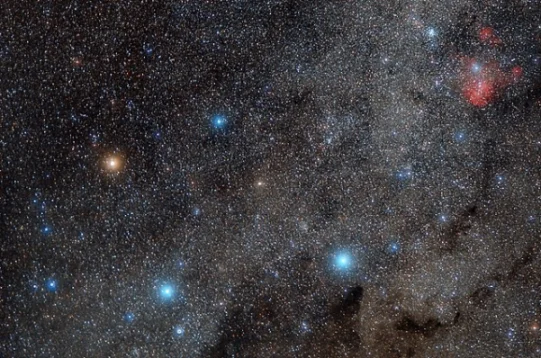
The Southern Cross, image: Antonio Ferretti (CC BY-SA 4.0)
Imai (Delta Crucis)
Imai (Delta Crucis) is a hot, massive blue subgiant star of the spectral type B2 IV. It is the most distant of the Southern Cross stars. It shines at magnitude 2.79 from a distance of 345 light-years. The star has a mass of 8.9 solar masses and a radius 8 times that of the Sun. It shines with 10,000 solar luminosities and has a surface temperature of about 22,570 K.
Imai is an exceptionally fast spinner, with a projected rotational velocity of 210 km/s. Its estimated age is only 18.1 million years.
Like Mimosa, Imai is classified as a Beta Cephei variable.
The name Imai comes from the culture of the Mursi people of Ethiopia. The Mursi use bright southern stars for their calendar, to track the seasonal flooding of the Omo river. When Imai stops appearing in the evening sky at sunset in late August, it is said that the river rises high enough to flatten the imai grass on its banks. The International Astronomical Union (IAU) formally approved the name in 2018.
In Portuguese, Imai is sometimes known as Pálida (the pale one).
Ginan (Epsilon Crucis)
Ginan (Epsilon Crucis) is a giant star of the spectral type K3 III. It has an apparent magnitude of 3.58 and lies approximately 230 light-years away.
The star has a mass of 1.52 solar masses and a radius 28.41 times that of the Sun. With a surface temperature of 4,294 K, it is 302 times more luminous than the Sun. It is a relatively slow spinner, with a projected rotational velocity of 3.14 km/s. the star’s estimated age is 2.17 billion years.
The name Ginan comes the language of the Wardaman people, an Aboriginal group in the Northern Territory of Australia. It refers to a dilly bag (the Bag of Songs). The name was approved by the IAU in 2017.
In Portuguese, Epsilon Crucis was known as Intrometida (the intrusive one).
Location
The Southern Cross lies in the far southern sky, at the forefeet of Centaurus. It is the most prominent of the three cross asterisms in the southern celestial hemisphere. The other two asterisms – the False Cross and the Diamond Cross – are formed by stars in the constellations Carina and Vela.
Observers often mistake the larger and slightly fainter False Cross for the Southern Cross. The easiest way to distinguish between the two is to look for the Southern Pointers, Alpha and Beta Centauri. A line extended from Alpha Centauri through Beta Centauri leads to within a degree of Gacrux, the star at the top of the Southern Cross. Additionally, the relatively bright fifth star (Ginan) makes the true Southern Cross look a bit different than the two fainter asterisms.
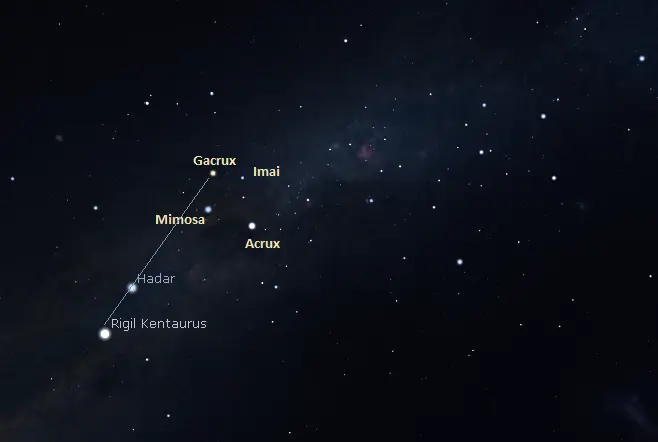
Southern Cross location, image: Stellarium
The False Cross is oriented in approximately the same way, but the four stars – Avior and Aspidiske in Carina and Alsephina and Markeb in Vela – are located a bit farther to the north, and they do not point to the south celestial pole. They will, however, mark the pole’s location around the year 8600, when the pole has gradually shifted to a point just east of the intersection of the cross-arms of the False Cross.
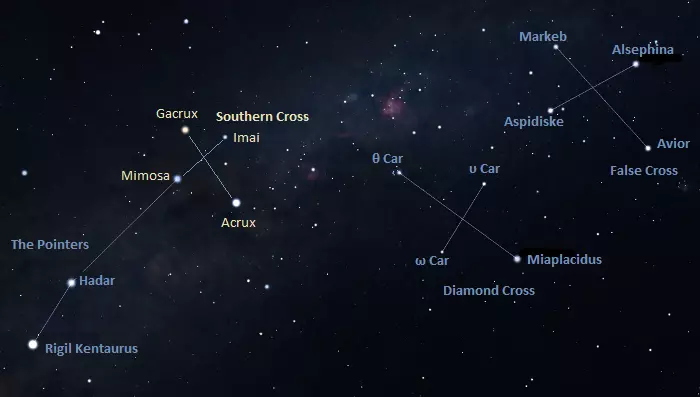
The Southern Cross, Diamond Cross and False Cross, image: Stellarium
How to find the Southern Cross?
The Southern Cross is circumpolar to the southern hemisphere and always appears in the southern sky for most observers. Depending on the time of the year (or night), the asterism may appear higher or lower above the horizon or be upside down.
The image below shows the Southern Cross as it appears from Australia and New Zealand at 10 pm in the evening at different times of the year.
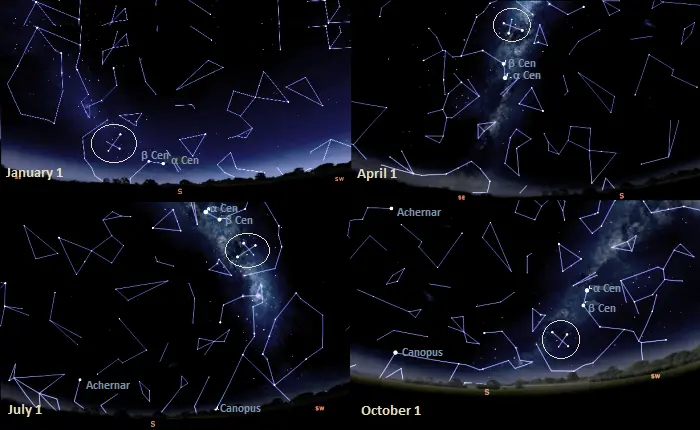
The Southern Cross as it appears at different times of the year, image: Stellarium
Where can you see the Southern Cross?
In the southern hemisphere, the Southern Cross is visible from any location at any time of the year. The constellation Crux is circumpolar in southern latitudes, i.e. it can be seen throughout the year at some point during the night.
The entire constellation is visible from locations south of the latitude 20° N. The southernmost star in the Southern Cross asterism, Acrux, has the declination -63° 05’ 57’’, which means that, depending on geography, the asterism can be seen south of the latitude 27° or 26° N.
Observers in the northern tropical latitudes can see the asterism during the northern winter and spring, when it makes an appearance above the southern horizon for a few hours every night.
The best time of year to observe the stars of the Southern Cross is in late April and May, when the asterism appears high above the horizon in the evening sky.
How to find the south celestial pole using the Southern Cross?
Like the Big Dipper, whose bright Pointer Stars show the way to the North Star, the Southern Cross can be used to find the location of the South Star and the south celestial pole. The asterism has been used by navigators for centuries. The longer bar of the cross-shaped star pattern points almost exactly to the pole in the sky. Aviators and sailors sometimes refer to this point as the “south polar pit” because there are no bright stars marking it. The pole is found by simply extending a line from Gacrux through Acrux by about 4.5 times the distance between the two stars.
The south celestial pole can also be located by drawing a line from Gacrux through Acrux and another line perpendicular to the line connecting Alpha and Beta Centauri. The point where these two lines intersect appears 5-6 degrees from the pole.
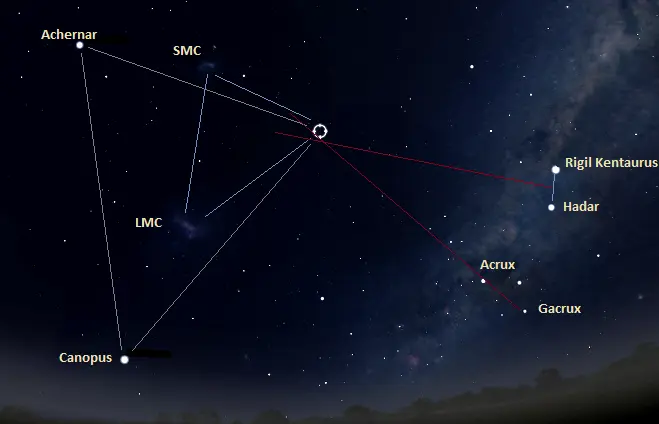
The Southern Cross and south celestial pole, image: Stellarium
Constellations near the Southern Cross
The Southern Cross is surrounded by the larger Centaurus on three sides. The fainter but recognizable Musca (the Fly) lies to the south.
Centaurus is the 9th largest and one of the brightest constellations in the sky. The entire constellation never rises for most observers in the northern hemisphere, but its brightest stars are well-known to southern observers. Centaurus is home to Rigil Kentaurus (Alpha Centauri) and Hadar (Beta Centauri), the third and 11th brightest stars in the sky. Alpha Centauri is also the nearest star system to the Sun, located only 4.37 light years away.
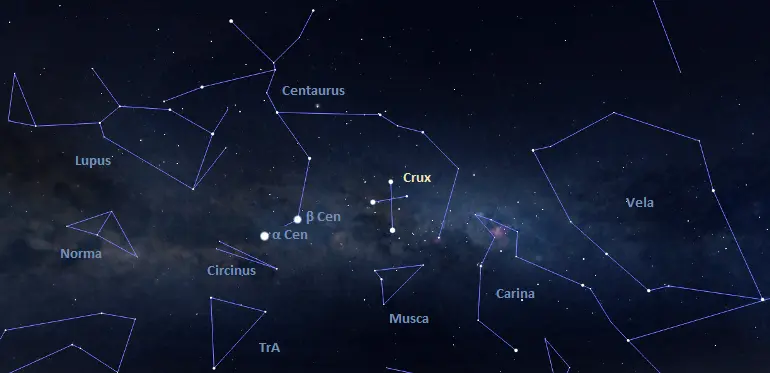
The constellations near the Southern Cross, image: Stellarium
Musca is much smaller and fainter but can be made out using the stars of the Southern Cross. Representing the Fly, the constellation is found by extending a line from Gacrux through Acrux. Its brightest star, the hot blue Beta Cephei variable Alpha Muscae, shines at magnitude 2.69.
Deep sky objects
The region of the Southern Cross is packed with deep sky objects visible in small and medium telescopes. Some of them can even be seen without binoculars.
The largest of these is the Coalsack Nebula, a vast dark nebula that extends into the neighbouring constellations Centaurus and Musca. The interstellar dust cloud is the most prominent dark nebula in the sky, stretching across an area of 7 by 5 degrees. It is easily visible on a clear night near Acrux and Mimosa, the brightest stars of the Southern Cross.
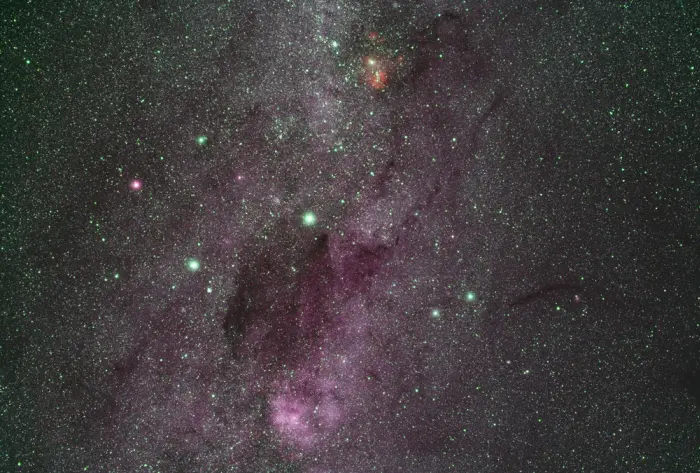
Shining in the southern sky, the four bright stars portrayed in the left part of this image represent a useful orientation mark which helps identifying the South Celestial Pole. Because of the rather distinctive asterism they form, these stars have been officially classified as the Crux constellation, or the Southern Cross. The vast dark cloud, visible in the lower part of the image, is usually referred to as the Coalsack Nebula; it also has a preeminent role in the Australian Aboriginal culture, representing the head of an emu in the traditional constellation of the “Emu in the Sky”. The ruddy object glowing in the upper part of the image owes its colour to the blaze of hydrogen gas. Catalogued as IC 2948, this emission nebula hosts a sparkling cluster of young stars. Image credit: ESO/Yuri Beletsky (CC BY 4.0)
In Australian Aboriginal mythology, the Coalsack represents the head of the “Emu in the sky.” The celestial Emu is an extension of the Great Rift, the dark band of dust that obscures the Milky Way centre and extends across the bright band of our galaxy past the Galactic centre in Sagittarius all the way to the Northern Cross in Cygnus.
The Jewel Box Cluster (NGC 4755), a bright young open cluster with an integrated visual magnitude of 4.2, can be found about a degree southeast of Mimosa. With an apparent size of 10.3 arcminutes, the cluster is one of the finest telescope targets in the far southern sky. NGC 4755 is also known as the Kappa Crucis Cluster, after one of its brightest members. Kappa Crucis, a bright blue supergiant of the spectral type B3Ia, shines at magnitude 5.98 from a distance of 7,500 light years. The Jewel Box Cluster is visible to the unaided eye on a clear night. Its estimated age is only 14 million years.
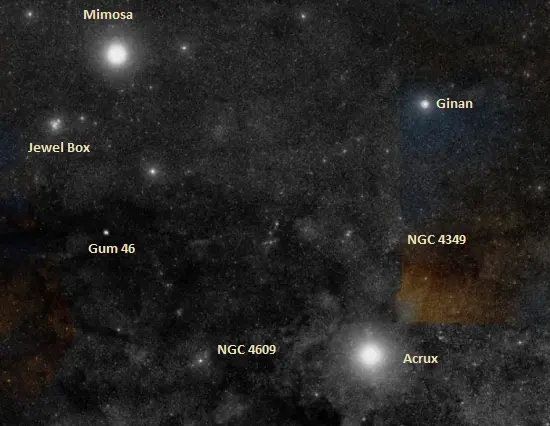
Acrux, Mimosa, the Jewel Box Cluster, NGC 4609, NGC 4349 and Gum 46, image: Wikisky
The fainter open cluster NGC 4852 appears east of Gacrux, in the same area as the Jewel Box.
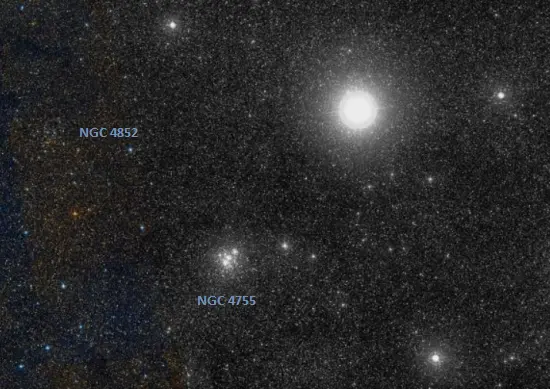
Mimosa, the Jewel Box Cluster and NGC 4852, image: Wikisky
Several fainter star clusters appear near the stars of the Southern Cross. The open cluster NGC 4609 lies a couple of degrees west of Acrux. It has an apparent magnitude of 6.9 and occupies 5 arcminutes of the apparent sky. The emission nebula Gum 46, ionized by a hot blue O-type star, lies between the Jewel Box and NGC 4609. Another open cluster, NGC 4349 (mag. 7.49), appears between Acrux and Ginan.
A fainter open cluster, NGC 4337, appears roughly halfway between Gacrux and Imai.
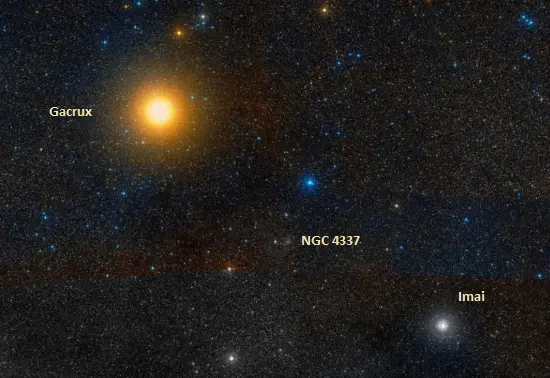
Gacrux, Imai and NGC 4337, image: Wikisky
Facts
Three of the five bright stars of the Southern Cross are likely members of the Scorpius-Centaurus association, the nearest OB association to the Sun. Imai, and probably Acrux and Mimosa, are members of the Lower Centaurus-Crux (LCC) subgroup of the association. All three are massive, hot, blue B-type stars. They were likely formed in the same molecular cloud within the last 20 million years and share a common proper motion. The red giant Gacrux and orange giant Ginan do not belong to the group.
The Southern Cross spans only six degrees from north to south, a distance only slightly greater than the one between Merak and Dubhe, the Pointer Stars in the Big Dipper, which point the way to Polaris, the North Star, in Ursa Minor.
The constellation Crux lies exactly opposite Cassiopeia in the sky and the two can never be visible at the same time.
The Southern Cross was visible in the northern hemisphere about 5,000 years ago, including most of North America, as well as Babylonia and Greece. Crux stars were even visible from Britain in the 4th millennium BCE.
Richard Hinckley Allen, a 19th century expert in stellar nomenclature, noted that the stars of the Southern Cross were last visible on the horizon in Jerusalem around the time that Christ was crucified. As a result of precession, the Southern Cross eventually sank below the horizon for most of the northern hemisphere.
The Portuguese astronomer and astrologer João Faras, the physician of King Manuel I of Portugal, is credited as the first European to depict the constellation Crux correctly. He sketched it in Brazil on May 1, 1500, in a letter sent to the king.
Portuguese sailors mapped Crux for navigation while sailing near the southern tip of Africa. Italian explorer Amerigo Vespucci was one of the first Europeans to see the “four stars” as he called them, during his second voyage in 1501. Vespucci also observed the nearby Coalsack Nebula.
Italian explorer Andrea Corsali, who sailed to China and the East Indies from 1515 to 1517, also described Crux as a separate constellation. Corsali drew a map of the southern sky that included the bright stars of Crux, the stars near the south celestial pole, and the Large and Small Magellanic Clouds.
The first uranographers to depict Crux as a separate constellation were the English globe maker Emery Molyneux and the Dutch-Flemish astronomer Petrus Plancius in 1592. They both placed the constellation in the wrong position.
The first accurate depiction of Crux on a celestial globe is credited to Petrus Plancius in 1598 and the Dutch-Flemish cartographer Jodocus Hondius in 1600.
The Dutch explorer Frederick de Houtman was the first to catalogue Crux stars separately from Centaurus during the first Dutch expedition to the East Indies from 1595 to 1597. German astronomer Jakob Bartsch adopted Crux as a separate constellation in 1624, and French astronomer Augustin Royer did so in 1679.
Over the next millennia, precession will take the stars of Crux even closer to the south celestial pole, up to declination 67° S. However, by the year 18,000, the Southern Cross will have moved as far as north as the declination 30° S. At this point, it will be visible from most of Europe and the United States.
Southern Cross flags
The stars that form the Southern Cross are represented on the national flags of Australia, New Zealand, Papua New Guinea, Samoa, and Brazil. The Southern Cross is also mentioned in the national anthems of Australia and Brazil.
On the flag of Brazil, the five stars of the Southern Cross represent the Brazilian states São Paulo (Acrux), Rio de Janeiro (Mimosa), Bahia (Gacrux), Minas Gerais (Imai), and Espírito Santo (Ginan).

The Southern Cross is also featured on many flags of cities, districts and provinces in Australia and South America. These include the Santa Cruz and Tierra del Fuego provinces in Argentina, the Coquimbo, Los Lagos, and Magallanes regions in Chile, and the Colonia Department in Uruguay.
Mythology and culture
The Southern Cross carries significance across many southern cultures and civilizations. It was an important symbol to the Egyptians and the Aborigines among other cultures. The Egyptians saw it as representative of the place where Horus was crucified, marking the passage of winter. The Aborigines and the Maori saw the asterism as symbolizing animist spirits that were integral to their ancestral beliefs. The Aborigines saw Crux and the Coalsack Nebula as marking the head of the “Emu in the Sky.”
The Southern Cross was found depicted on a stone engraving in Machu Picchu. The Incas knew it as “Chakana,” meaning “stair,” and it played an important part in Incan mysticism, symbolizing the three tiers of the world: the heavens, the world of the living, and the underworld.
The first documented example of the discovery of the Southern Cross was found in Ancient Greece around 1000 BCE. Ancient Greeks considered Crux to be part of Centaurus constellation. The asterism could be seen from Athens at the time, but it was low in the sky. Once the precession of the equinoxes took the whole constellation below the horizon for European observers, the five bright stars of Crux were gradually forgotten.
In traditional Chinese astronomy, Acrux, Mimosa, Gacrux and Imai formed an asterism known as Cross (十字架). The four stars were known as the First (Gacrux), Second (Acrux), Third (Mimosa), and Fourth (Imai) Star of the Cross. The modern name of the western constellation Crux in Chinese is 南十字座 (nán shí zì zuò), meaning “the southern cross-shaped constellation.”